This page was written because of a chapter in Weird and Tragic Shores: The Story of Charles Francis Hall, Explorer by Chauncey Loomis. Chapter Three, Frobisher Bay - Exploration, has a short history of Martin Frobisher's adventures around Baffin Island in the 16th Century.
For a major sea port, Bristol has not played a major part in the history of polar adventure and discovery but none the less does have some interesting links to it, and some are tragic.
Newfoundland
It is generally accepted that John Cabot discovered Newfoundland during the May to August 1497 voyage of the Matthew. There is some evidence that English and other European fishermen had known about it for quite some time before that. It may have been that Cabot's discovery of it wasn't that much of a big deal. In 1662, in his The History of the Worthies of England. volume III, Thomas Fuller wrote "Hugh Eliot, a merchant of this city, who was, in his age, the prime pilot of our nation. He first (with the assistance of Mr.[Robert] Thorn his fellow-citizen) found out Newfoundland, anno 1527."
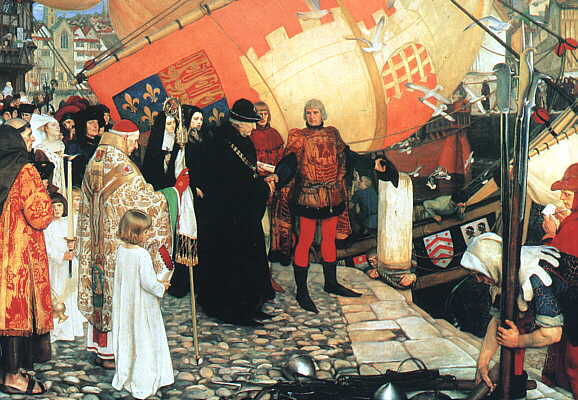
The Departure of John and Sebastian Cabot
Martin Frobisher (1535 or 1539 - 1594)
Frobisher left England with two ships, the Gabriel and Michael on June 7, 1576 . His sponsors, a group of London merchant venturers headed by Michael Lok wanted Frobisher to look for the northwest passage. Just off of Greenland the Michael turned round and headed for home after the ships were separated by a storm. On her arrival, the Michael reported the Gabriel as being lost - but it wasn't.
After exploring Frobisher Bay in the southeast of Baffin Island, which he thought was a strait, Frobisher returned home in the Gabriel. He had promised Lok that he would bring back with him "the fyrst thinge that he founde in the new land," and true his word he gave Lok a rock he had picked up on Hall Island.
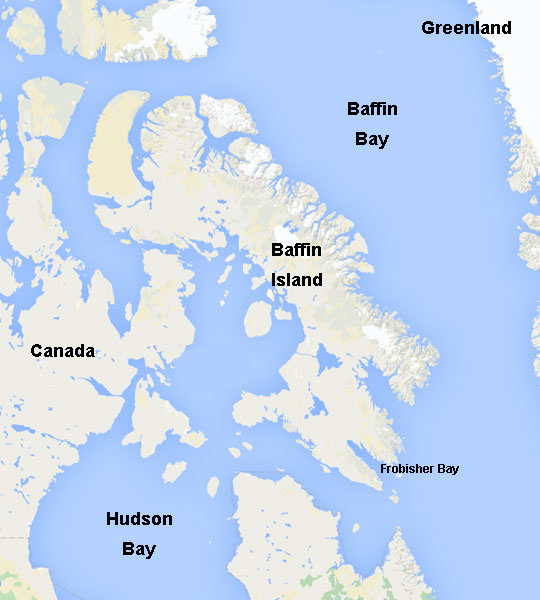
Baffin Island
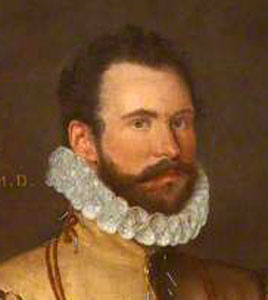 |
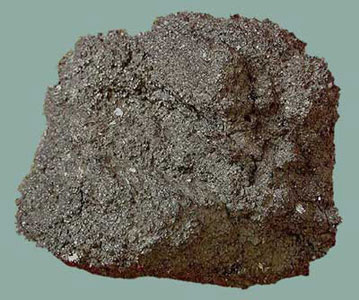 |
| Sir Martin Frobisher in 1577 Image from http://en.wikipedia.org/wiki/Martin_Frobisher |
A sample of Frobisher's "black earth," actually Amphibolite Image from http://www.renewton.plus.com/geology/walks/2010/Lapworth/ |
Lok had the rock essayed by several people but none could find anything valuable in it. Then an Italian essayer, Giovanni Agnello, said that it was rich in gold. Lok must have known something was wrong because he apparently asked the essayer how he managed to find anything valuable in it when others had not. He received the reply "It is necessary to know how to flatter nature."
Lok then formed the Cathay Company with himself as Governor and Frobisher as "High Admyrall." Queen Elizabeth I invested £1,000 in the company. Finding the actual northwest passage was now secondary, what the company wanted was more of the gold laden ore. On May 27, 1577, the Gabriel and Michael accompanied by the Ayde departed England for the north. Between them they carried 150 men.
They found very little of the ore on Baffin Island but found plenty on either islands, they eventually brought home about 200 tons of it. The Ayde docked at Milford Haven on September 23, 1577, the Michael arrived at Yarmouth a little later and the Gabriel landed at Bristol. Sometime in October the Ayde also arrived in Bristol. Latimer in his Sixteenth Century Bristol says that the Privy Council ordered that the ore "should be lodged for safety in the Castle." He goes on to say that "Frobisher also brought three savages, doubtless Esquimaux, dressed in deer skins, but all of them died within a month of their arrival."
Frobisher never got on well with the natives of Baffin Island on any of the three expeditions he made there. He'd already brought back an Inuit and his kayak on the first expedition but he had died within a year in England. The three he brought back on the second expedition were also kidnapped. He named them Kalicho (also variously known as Callicho, Calichough, Calichoughe, Collichang or Cally Chough), Ignorth (also known as Egnock), and Nutaaq (also known as Arnaq or Nutioc) which are the Inuit words for man, woman and child.
The three were presented before the Mayor of Bristol, Thomas Colston and Kalicho demonstrated his skills by killing ducks on the River Avon from his kayak with his spear. Evans describes the incident. "The 9th of October the man rowed up and down the river at the Back, it being full sea, in a boat made of beasts' skins, in forme like unto a longe barge, or trowe, but sharp at both ends about fourteen feet long having but one rounded place for him to sett in; and, as he rowed up and down the river, he killed a couple of ducks with his dart. And at the Marsh he brought the boat out of the water, upon his back." Nicholls and Taylor say he also repeated this performance at the Weare.
Kalicho was already ill, he'd suffered broken ribs while being captured. One of Frobisher's crew, a Cornishman and wrestler named Nicholas Conger, had thrown Kalicho heavily to the ground breaking two ribs. Kalicho died of pneumonia, and an ulcerated and punctured lung. Ignorth was shown the body by Dr. Edward Dodding who performed the autopsy. Dr. Dodding wrote that Ignorth broke out in boils the day after. A week later Ignorth also died. The burials took place on November 8 and 13 and are recorded in St. Steven’s Church register. Ignorth's son Nutaaq, who had been shot in the arm while his mother was trying to resist capture on Baffin Island, was taken to London but he too died shortly afterwards.
The St. Steven’s Church register entries for 1577 contain the following:
Collichang a heathen man buried the 8th of November
Egnock a heathen woman buried the 12th of November
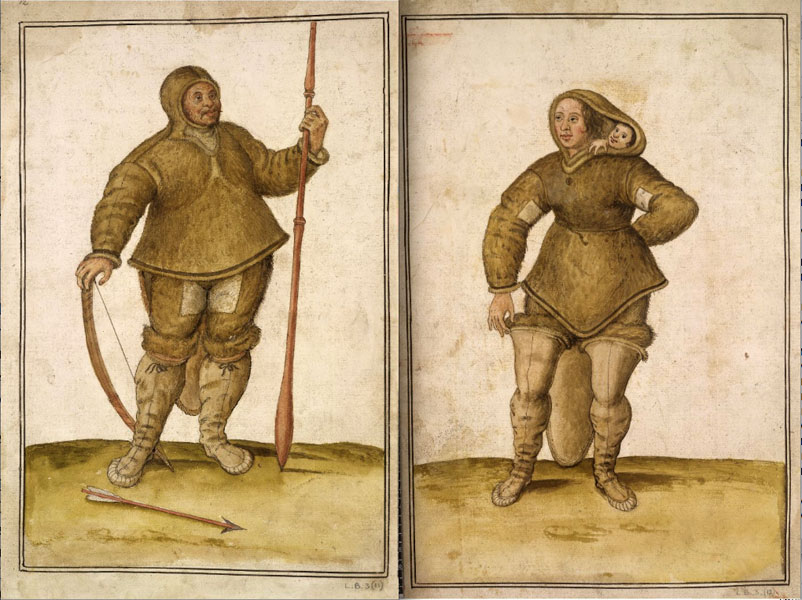
Kalicho, Ignorth and Nutaaq
Probably painted by John White who may have accompanied Frobisher and painted this on Baffin Island
On June 3,1578, Frobisher was admiral of 15 ships that left Plymouth; the Ayde, Michael, Gabriel, Judith, Dennis or Dionyse, Anne Francis, Francis of Foy, Moon of Foy, Bear of Leycester, Thomas of Ipswich, Thomas Allen, Armenall, Soloman of Weymouth, Hopewell, and Emanuel of Bridgwater. The ships had enough supplies to set up a permanent colony of 100 men on Baffin Island.
The surviving ships returned home in the beginning of October, but it was found that all 2,000 tons of the ore they had brought back was valueless. Most of it was used to repair roads, but apparently not all of it. In his book, which was originally written in 1971, Loomis writes "the rest apparently was thrown into Bristol Harbor, tons of it were found there when the harbor was dredged only a few decades ago." Nicholls and Taylor say the ore was tested again in both Bristol and London, "the result was a speck of gold about the size of a pin's head, which is still preserved stuck on the seal of the report." Anthony Brandt, in his book, The Man Who Ate His Boots: The Tragic History of the Search for the Northwest Passage says that in Priory Road, Dartford, Kent there is a wall made from some of the ore that Frobisher brought back from Baffin Island.
Michael Lok spent some time in debtor's prison for this fiasco. A place he got to know quite well as he was there eight times on different occasions. Frobisher was a lucky man. Despite losing a total of total of £20,000, including £3,500 of the Queen’s money on the three Frobisher Bay expeditions in the search for the gold on Baffin Island, the Queen still trusted him and used him for various missions, mostly privateering. He was recklessly brave during the attack by the Spanish Armada in 1588 and was knighted. He was wounded leading a marine attack on Crozon near Brest in November 1594, and died on November 15.
His memory lived on for a long time with the Inuit of Baffin Island. Charles Francis Hall heard of him from the Inuit when he was exploring Baffin Island in the 1850s - some 300 hundred years after Frobisher had dug for gold there.
I am very grateful to Brian Glover who actually lives in Dartford. He emailed me in September 2017 and pointed out that I had originally misquoted Brandt and wrote Dartmouth instead of Dartford. Frobisher had much of the ore he brought back smelted in Dartford. Brian also very sent me a picture of the wall.
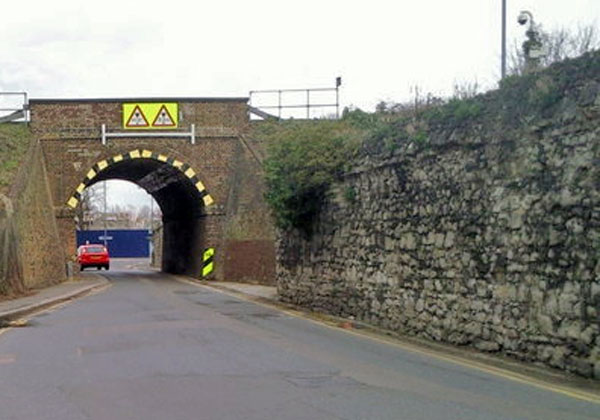
The wall in Priory Road, Dartford, Kent made from some of the ore that Frobisher brought back from Baffin Island
Image from Brian Glover
While reading material for this short article I came across an interesting proposition. The origin of London's streets being paved with gold was supposed to be Dick Whittington (1354–1423) and his cat. The earliest reference to that event started around 1604 in a script for a play. Some people wonder whether the real inspiration for that was the repair of what few metalled roads there were at the time with Frobisher's supposedly gold-rich rock less than ten years previously.
I used several online calculators to try and estimate how much £20,000 in 1580 would be worth today. I got answers ranging from £3.3 million to £5.6 million. Whatever it was, it was a lot of money for some rock, even around 2,500 tons of it.
Thomas James (1593 - 1635)
Thomas James was thought to have been born in Bristol around 1593. In 1631, a group of Bristol merchants selected him to search Hudson Bay for a passage through to the Pacific - the northwest passage. He sailed from Bristol on May 3, 1631 in the Henrietta Maria. James could not find any such passage and had to spend the winter near the northeast corner of Charlton Island in James Bay to the south of Hudson Bay. He returned home on October 22, 1632, and in 1633, wrote of his adventures in The Strange and Dangerous Voyage of Captaine Thomas James.
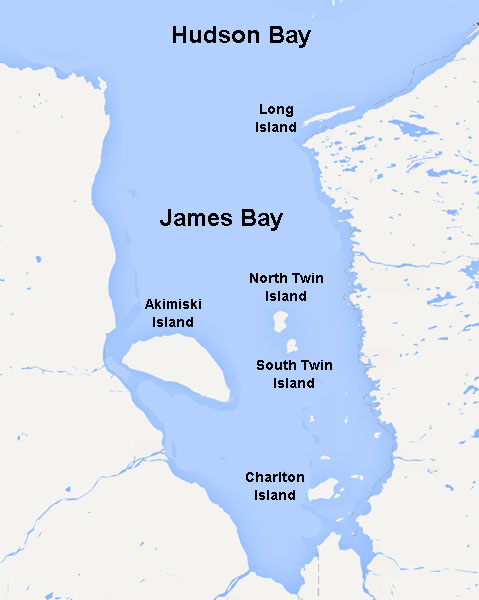
James Bay
He was just the fourth explorer to overwinter in the arctic the others being Henry Hudson (1610-1611), Thomas Button (1612-1613), and Jens Munk (1619-1620), and had explored more coastline than any of them. He only lost 6 men, two due to accident and 4 to scurvy, of the 22 he had with him. In contrast Button's and Munk's crews were practically wiped out with Munk losing losing 61 men of the 64 with him.
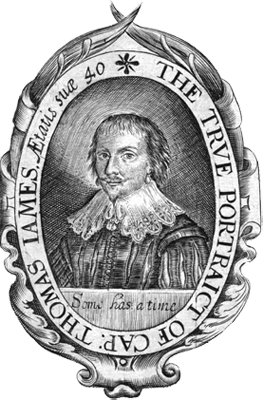
Thomas James
Within a couple of months of arriving back in Bristol, James was back at sea as captain of the 9th Whelp of the Lion, patrolling the Bristol Channel and Irish Sea for pirates. He died just a year or two later in 1635 and may be buried in the Lord Mayor's Chapel in Bristol.
Matthew Liddon (1790 or 1792 - 1869)
Matthew Liddon joined the Royal Navy in 1804, and while serving in the West Indies he was captured by French privateers. On his return to England, he joined HMS Pheasant in 1806, participating in an expedition to the Rio de la Plata under Sir Samuel Auchmuty. Between 1808 and 1818, he served in a succession of ships off the coasts of North America and Britain and in the Mediterranean, advancing to the rank of lieutenant in 1811.
In 1819, he took command of HMS Griper on the British Naval Northwest Passage Expedition, under the command of William Edward Parry, sailing in company with HMS Hecla to the Canadian Arctic to seek a passage through Lancaster Sound.
Setting out from London in May 1819, the expedition reached Davis Strait before proceeding to Lancaster Sound where the two vessels continued westward, exploring Prince Regent Inlet before progressing along Barrow Strait. On September 6,1819, Parry crossed the meridian of 110° West, off the south shore of Melville Island, earning a prize of £5,000 that had been offered by Parliament for reaching this longitude. Prevented from progressing still further west by ice conditions, the expedition wintered at Winter Harbour on Melville Island, where the vessels remained until August 1, 1820.
An island in Fury and Hecla Straight, under the northwest portion of Baffin Island, is named after him.
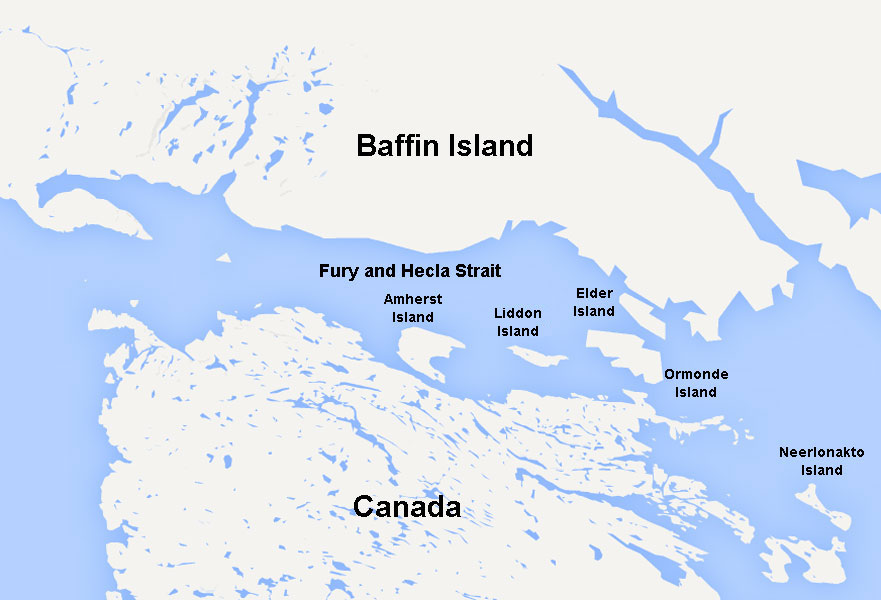
Liddon Island
After the expedition, Liddon was paid off in December, 1820. He did did not serve at sea again, advancing to the rank of commander in 1821 and retiring as captain in 1856. He died on August 31, 1869 in Clifton, Bristol. He is buried in Arnos Vale Cemetary.
Robert Falcon Scott (1868 - 1912)
The story of Scott has been told many times before, but here are a few bits and pieces that concern Bristol.
In 1909, Scott undertook a lecture tour of Britain to try and raise the £40,000 needed for his attempt on the South Pole. It did not go well. Scott wrote dejectedly "Between £20 and £30 from Wolverhampton...£40 today...nothing from Wales...this place won't do, I'm wasting my time to some extent...I don't think there is a great deal of money in the neighbourhood...things have been so-so here...I spoke not well but the room was beastly and attendance small...another very poor day yesterday, nearly everyone out." However he did manage to raise £2,000 in Manchester, £1,387 in Cardiff and £750 in Bristol.
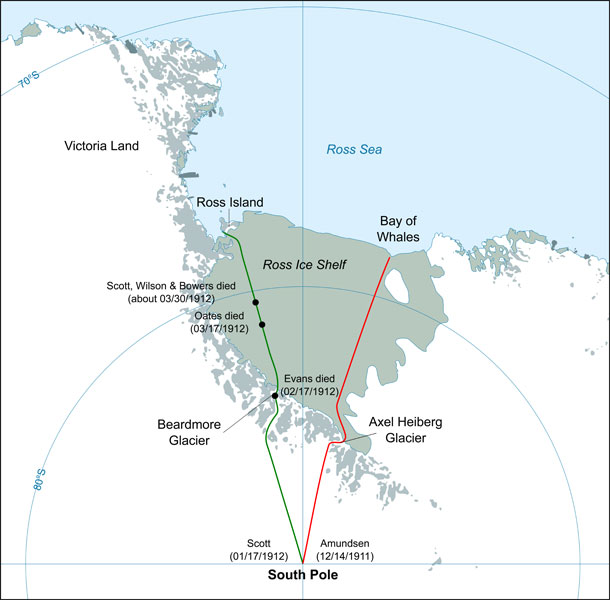
The routes taken by Scott and Amundsen to the South Pole
Image from
http://en.wikipedia.org/wiki/Terra_Nova_Expedition
Sir Raymond Edward Priestley (1886-1974), was born on 20 July 1886 at Tewkesbury, Gloucestershire. He was educated at Tewkesbury Grammar School where his father was headmaster. Priestley was in the final year of science at University College, Bristol, when he was appointed geologist to Ernest Shackleton's 1907-09 Antarctic expedition. Priestley was recruited to Robert Falcon Scott's second Antarctic expedition of 1910-13, again as a geologist, although his actual scientific work covered a broad area. He went on to become principal and vice-chancellor of the University of Birmingham.
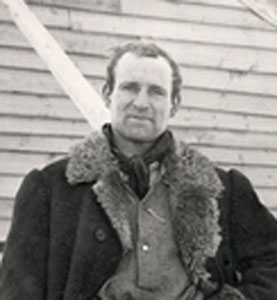
Raymond Edward Priestley
Edward Adrian Wilson was with Scott when he reached the South Pole. The others were Lawrence "Titus" Oates, Henry Robertson "Birdie" Bowers and Edgar Evans. Bristol has a small connection with Wilson. He was born in Cheltenham on July 23 1872, and when he was around 11, he was sent to a Preparatory boarding school, run by a Mr. Wilkinson, in Clifton. He did not pass the necessary exams to get a public school scholarship and so returned to Cheltenham to attend the Cheltenham Proprietary College for Boys.
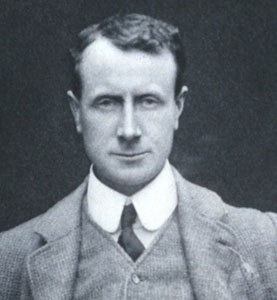
Edward Adrian Wilson
Bristol has a stronger connection with another ember of Scott's 1912 expedition, Harry Dickason. Dickason was born in Clifton, Bristol on December 16,1884, and although not on the final team to make the South Pole, he was lucky to survive as a member of Scott's Northern Party.
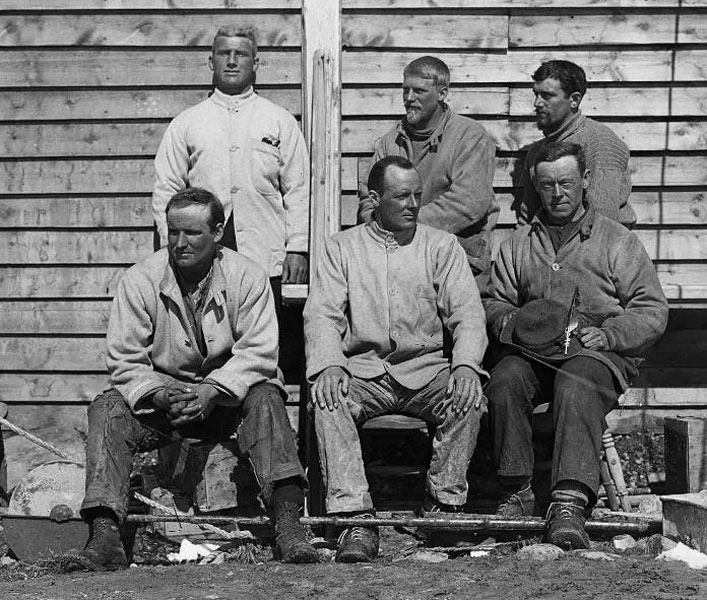
The Northern Party at Cape Adare in 1914.
Standing from left: George Abbott, Harry Dickason and Frank Browning.
Seated from left: Raymond Priestley, Victor Campbell and Murray Levick.
This was a group of six men led by Victor Campbell, which carried out scientific research and exploration on the coast of Victoria Land and the Ross Ice Shelf. They spent two winters at Cape Evans on Ross Island and when the expedition ship Terra Nova was unable to pick them up, they spent seven months in a snow cave on Inexpressible Island, surviving as best they could on limited supplies, before they could get back to the Cape Evans base. In the underground ice-cave they lived in awful conditions - freezing, suffering from dysentery and near starvation. They were often sick because of the smoke and smell of the blubber used for heating and cooking.
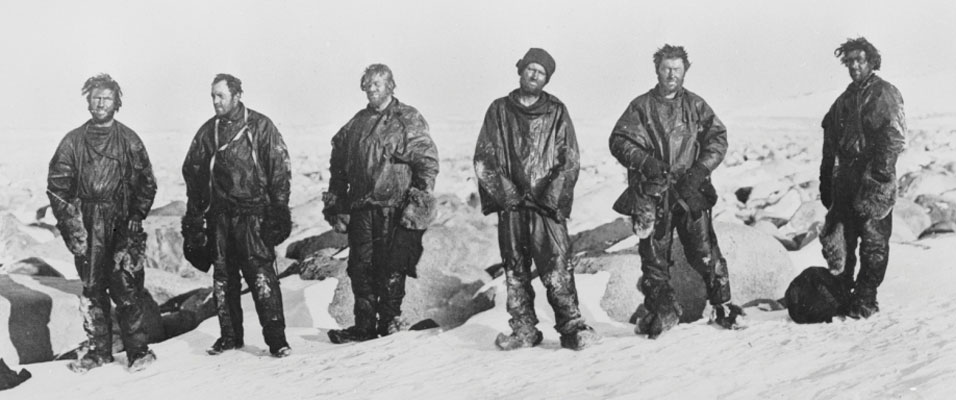
The Northern Party on 24 September 1912.
From L to R: Harry Dickason, Victor Campbell, George Abbott, Raymond Priestley, Murray Levick and Frank Browning.
Image from
http://www.scottslastexpedition.org/expedition/science-in-the-first-winter/
Dickason remained in the Royal Navy on his return from the Antarctic and was promoted to Chief Petty Officer. He was pensioned-off from the Royal Navy on December 18. 1924 and died on and died on December 3,1943, in St. James’ Hospital, Wandsworth.
Many of the items at Scott's camps, especially the Cape Evans and earlier 1902 expedition camp at Discovery Hut, are in a remarkable state of preservation and conservators are ensuring that they do not deteriorate. The items include boxes and tins of cocoa powder donated by Fry's. Eleven tins were found in 1955 in one of Scott's supply depots and returned to Fry's Somerdale factory at Keynsham. At the time of Scott's expedition the factory would still have been in Union Street as it did not start to move to Keynsham until 1923.
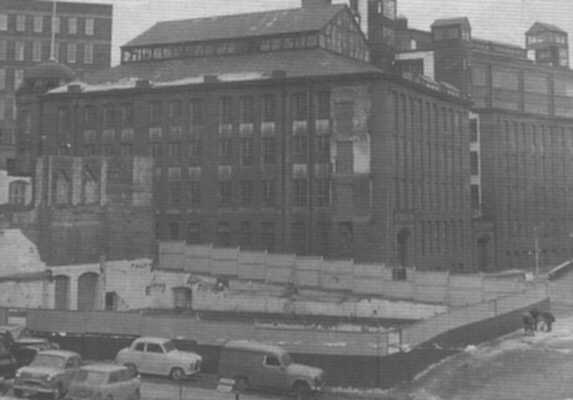
Fry's Factory in Union Street
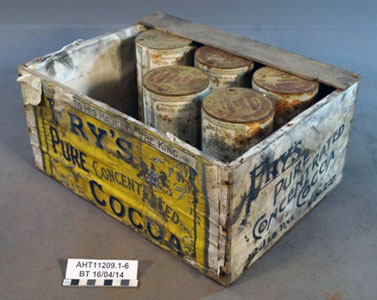
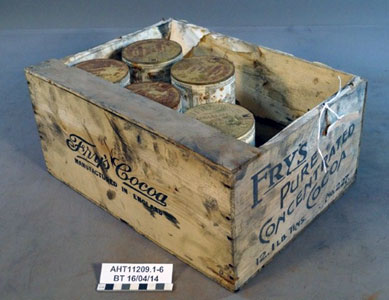
Case of Fry's Cocoa Powder
Images from
http://www.nhm.ac.uk/natureplus/community/antarctic-conservation?view=blog
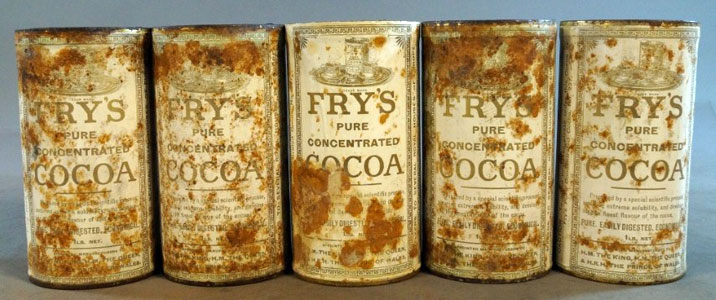
Tins of Fry's Cocoa
Image from
http://www.nhm.ac.uk/natureplus/community/antarctic-conservation?view=blog
The tins are 17cm in height and 9cm in diameter. The labels read, "Prepared by a special scientific process securing extreme solubility, and developing the finest flavour of the cocoa. PURE. EASILY DIGESTED. ECONOMICAL. 1LB NET. APPOINTED MANUFACTURER TO H.M. THE KING, H.M. THE QUEEN, AND H.R.H. THE PRINCE OF WALES'. Printed sideways along the tin are the words 'CAUTION. To avoid mistakes please order this Cocoa as Fry's Pure Concentrated Cocoa, No. 227'
Scott's expedition took 2 tons of cocoa powder with them - about 200 cases of it.
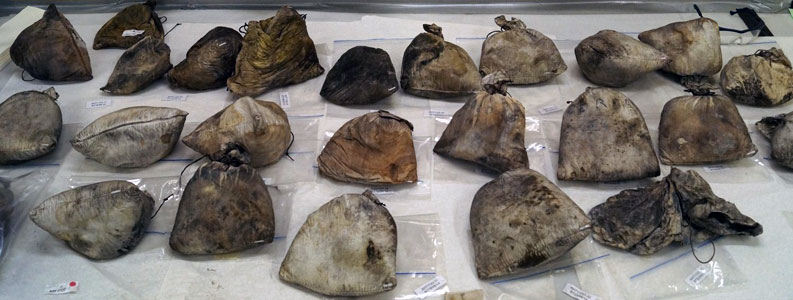
Sledging ration bags containing cocoa powder, cereals, flour and spices
Image from
http://www.nhm.ac.uk/natureplus/community/antarctic-conservation?view=blog
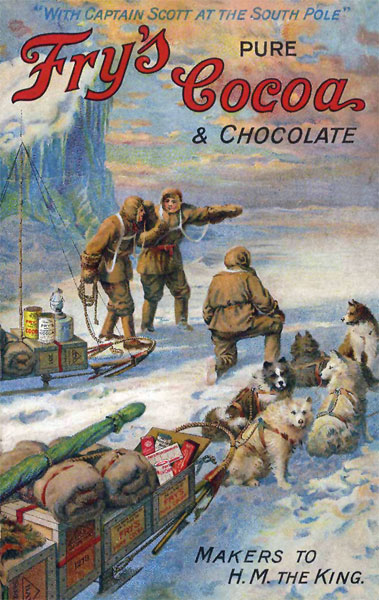
Advertising by Fry's showing the Scott Expedition
Scott had seen how well ponies had served Shackleton on his 1907 - 1909 expedition, hauling supplies to the foot of Beardmore Glacier. Several organizations in England either provided ponnied or the funds for them including the Bristol Savages that supplied a pony named Punch.
The London Savages were formed in 1857 and the Bristol club formed in 1894. They consisted of "gentlemen connected with literature and the fine arts, and warmly interested in the promotion of knowledge, and the sale of exciseable liquor."
Unfortunately the ponies were not so useful to Scott as they were to Shackleton and most of them had to be shot. Scott's journal entry of Friday, March 3, 1911, describes what happened to Punch.
I went along the Barrier edge and discovered what I thought and what proved to be a practicable way to land a pony, but the others meanwhile, a little overwrought, tried to leap Punch across a gap. The poor beast fell in; eventually we had to kill him – it was awful. I recalled all hands and pointed out my road. Bowers and Oates went out on it with a sledge and worked their way to the remaining ponies, and started back with them on the same track. Meanwhile Cherry and I dug a road at the Barrier edge. We saved one pony; for a time I thought we should get both, but Bowers’ poor animal slipped at a jump and plunged into the water: we dragged him out on some brash ice – killer whales all about us in an intense state of excitement. The poor animal couldn’t rise, and the only merciful thing was to kill it. These incidents were too terrible.
Sources
Newfoundland
Fuller, Thomas. (1662). The History of the Worthies of England. volume III, London: Thomas Tegg. Retrieved from https://archive.org/stream/worthiesengland03fulluoft/worthiesengland03fulluoft_djvu.txt
Martin Frobisher
Brandt, Anthony. (2010). The Man Who Ate His Boots: The Tragic History of the Search for the
Northwest Passage. New York: Random House. Retrieved from
https://books.google.com/books?id=nS-7QsieSPUC&pg=PA55
Cheshire Neil., Waldron, Tony., Quinn, Alison., Quinn, David. (1980, Summer). Frobisher's Eskimos in England.
Archivaria. (10):23-50 Retrieved from
http://journals.sfu.ca/archivar/index.php/archivaria/article/download/10808/11706
Dodding, Edward. (1577). The Death of an Inuit Man in England:
Postmortem report and comments of Dr. Edward Dodding. Retrieved from
http://nationalhumanitiescenter.org/pds/amerbegin/exploration/text3/dodding.pdf
Evans, John. (1824). A Chronological Outline of the History of Bristol and the Stranger's Guide through the Streets and
Neighbourhood. Bristol: Bristol Observer
Hird, Ed. (1998). BRE-X' Pirates Discover Canada. Deep Cove Crier. Retrieved from
http://www3.telus.net/st_simons/cr9811.htm
History Learning Site. (2014). Sir Martin Frobisher. Retrieved from
http://www.historylearningsite.co.uk/sir_martin_frobisher.htm
Latimer, John. (1908). Bristol: Arrowsmith
Loomis, Chauncey. (2000). Weird and Tragic Shores: The Story of Charles Francis Hall, Explorer. Modern Library
Exploration New York: Random House
Mansfield, Ian. (2011). Were London’s Streets Once Paved with Gold? IanVisits. Retrieved from
http://www.ianvisits.co.uk/blog/2011/10/08/were-londons-streets-once-paved-with-gold/
Mitchell, Mary Ames. (2014). 1577 Martin Frobisher’s Second Voyage. Before Winthrop. Retrieved from
http://beforewinthrop.com/section4/BW4-6b-MartinFrobisherNWPassage.html
Nicholls, James Fawckner & Taylor, John. (1881). Bristol Past and Present. Volume 1: Civil History. Bristol:
Arrowsmith
Thomas James
Davis, Richard Clarke. (1996). Lobsticks and Stone Cairns: Human Landmarks in the Arctic. Calgary: University of Calgary
Press. Retrieved from
https://books.google.com/books?id=CKisKFb0YKYC&pg=PA27
James, Thomas. (1633). The Strange and Dangerous Voyage of Captaine Thomas James.
London: John Partridge. Retrieved from
https://archive.org/stream/The_Strange_and_Dangerous_Voyage_of_Captaine_Thomas_James/Strange_and_Dangerous_Voyage
Matthew Lidden
Archives Hub. Matthew Lidden. Retrieved from
http://archiveshub.ac.uk/data/gb15-mathewliddon
Polly, Debra. (2012). Lieut Matthew Liddon. Findagrave.com. Retrieved from
http://www.findagrave.com/cgi-bin/fg.cgi?page=gr&GRid=98174701
Robert Falcon Scott
South-Pole.com. (2014). The TERRA NOVA Expedition 1910-13. Retrieved from
http://www.south-pole.com/p0000090.htm
Edward Wilson of the Antarctic. A Cheltenham Childhood: 1872-1891. Retrieved from
http://www.edwardawilson.com/component/content/article/7-life/3-a-cheltenham-childhood-1872-1891
Leclercq, Aline & White, Stefanie. (2014). Antarctic Conservation Blogs. Natural History Museum. Retrieved from
http://www.nhm.ac.uk/natureplus/community/antarctic-conservation?view=blog
Lowton, Bert. (2012). Harry Dickason. Retrieved from
https://sites.google.com/site/harrydickason/
Murray-Smith, S. (1988). Priestley, Sir Raymond Edward (1886–1974). Australian Dictionary of Biography. Retrieved
from
http://adb.anu.edu.au/biography/priestley-sir-raymond-edward-8116
Museum of New Zealand. Cocoa Tin, c1909. Retrieved from
http://collections.tepapa.govt.nz/exhibitions/whales/EducationResource.aspx?irn=504
Plymouth City Council. Old, New, Borrowed - or Blue. Retrieved from
http://www.plymouth.gov.uk/scott-supplies_and_equipment.pdf
Priestly, Raymond Edward. (1915). Antarctic Adventure: Scott's Northern Party. New York: Dutton. Retrieved from
https://archive.org/details/antarcticadventu00prie
Yates, Donna. (2013, Feb. 6). South Pole Exploration Artefacts Taken from Campsites of Robert Falcon Scott.
Trafficking Culture. Retrieved from
http://traffickingculture.org/encyclopedia/case-studies/south-pole-exploration-artefacts-taken-from-the-campsites-of-robert-falcon-scott/
Scott, Robert Falcon, (2004). Scott's Last Expedition Volume I. Project Gutenberg. Retrieved from
http://www.gutenberg.org/ebooks/11579
This page created 18th February 2015, last modified 17th September 2017